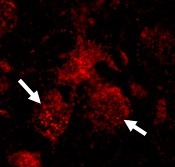 What causes brain damage and inflammation in severe cases of Gaucher disease? Little is known about the events that lead to brain pathology in some forms of the disease, and there is currently no treatment available– a bleak outlook for sufferers and their families.
What causes brain damage and inflammation in severe cases of Gaucher disease? Little is known about the events that lead to brain pathology in some forms of the disease, and there is currently no treatment available– a bleak outlook for sufferers and their families.Now, scientists at the Weizmann Institute of Science have discovered a new cellular pathway implicated in Gaucher disease. Their findings, published in Nature Medicine, may offer a new therapeutic target for the management of this disease, as well as other related disorders.
Gaucher disease is a genetic disorder most prevalent among the Ashkenazi Jewish population. It is caused by a defect in a particular enzyme needed to break down a fatty substance, or lipid, called glucocerebroside. This results in the accumulation of glucocerebroside in various cells and organs, which prevents them from working properly. There are three subtypes of the disease: The most common form– Type 1– is characterized by, among other symptoms, swelling and enlargement of the spleen and liver and disruption in the function of these organs, along with lung and bone problems. These symptoms can also affect individuals with Types 2 and 3 Gaucher disease, but what distinguishes them from Type 1 is the neurological involvement: Type 2– the most severe form– causes extensive brain damage and death before two years of age, while Type 3 is a more progressive form of the disease that affects the brain, with patients often living into their early teens and adulthood.
Indeed, although effective enzyme replacement therapy exists in which Gaucher patients are treated with injections of an intact version of the enzyme responsible for the normal breakdown of the lipid in healthy people, the cost of the lifelong treatment is approximately $200,000 per patient, per year. Moreover, the enzyme is unable to get into the brain since it cannot cross the blood-brain barrier, rendering it ineffective in treating the neurological symptoms of Types 2 and 3 Gaucher disease. Hence, more affordable and alternative treatments are urgently needed.
But what exactly causes such a massive loss of nerve cells in Types 2 and 3 Gaucher disease? It has recently come to light that a certain biochemical pathway, of which a protein called RIP3 is a key player, is involved in triggering the cell death and inflammatory processes that can have severe consequences in a number of diseases.
Dr. Einat Vitner and student Ran Salomon, in the lab of Professor Tony Futerman of the Biological Chemistry Department, wondered whether this could also be one of the missing links in the understanding of the chain of molecular events leading to brain inflammation and nerve cell death in Gaucher disease. To find out, they induced Gaucher disease in mice possessing the RIP3 protein, as well as in mice lacking RIP3. In mice lacking the RIP3 protein, they demonstrated not only a significant improvement in motor coordination and brain pathology but also improved liver and spleen function. Their lifespan was also remarkably increased from approximately 35 days to more than 170 days.
Vitner said: “These results are exciting, as they suggest a plausible new target for therapeutic intervention for all types of Gaucher disease; they have the potential, in the future, to greatly improve the patients’ quality of life.”
“If successful, the new target could be used as either a complementary or alternative therapy for Gaucher disease, and with RIP3 proving to be a ‘hot’ cellular pathway in various pathologies, these results may also have implications in other neurodegenerative diseases, including related diseases such as Krabbe disease, and potentially other devastating brain diseases,” said Futerman.
Date: January 20, 2014
Source: Weizmann Institute of Science
Filed Under: Drug Discovery




